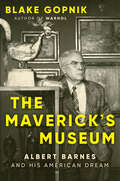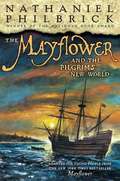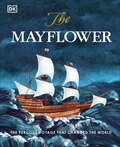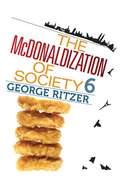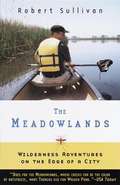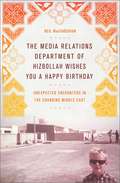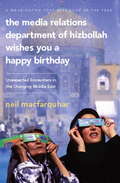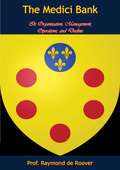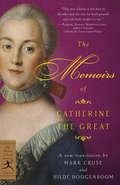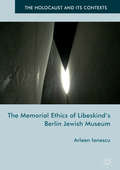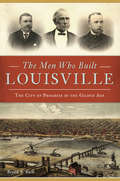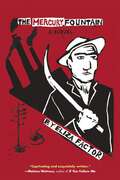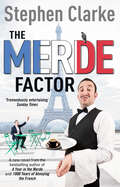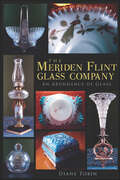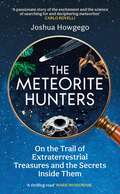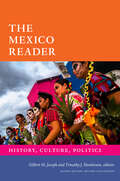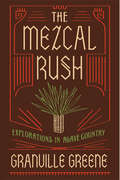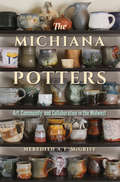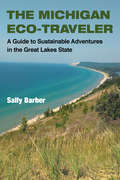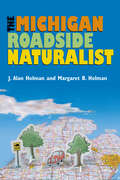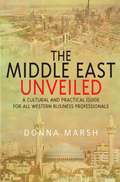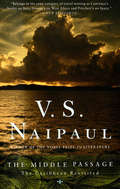- Table View
- List View
The Maverick's Museum: Albert Barnes and His American Dream
by Blake GopnikA fascinating biography of the philanthropist Albert Barnes, whose pioneering collection of modern art was meant to transform America’s soulFrom prominent critic and biographer Blake Gopnik comes a compelling new portrait of America’s first great collector of modern art, Albert Coombs Barnes. Raised in a Philadelphia slum shortly after the Civil War, Barnes rose to earn a medical degree and then made a fortune from a pioneering antiseptic treatment for newborns. Never losing sight of the working-class neighbors of his youth, Barnes became a ruthless advocate for their rights and needs. His vast art collection—181 Renoirs, 69 Cézannes, 59 Matisses, 46 Picassos—was dedicated to enriching their cultural lives. A miner was more likely to get access than a mine owner.Gopnik’s meticulous research reveals Barnes as a fierce advocate for the egalitarian ideals of his era’s progressive movement. But while his friends in the movement worked to reshape American society, Barnes wanted to transform the nation’s aesthetic life, taking art out of the hands of the elite and making it available to the average American.The Maverick’s Museum offers a vivid picture of one of America’s great eccentrics. The sheer ferocity of Barnes’s democratic ambitions left him with more enemies than allies among people of all classes, but for a circle of intimates, he was a model of intelligence, generosity, and loyalty. In this compelling portrait, Gopnik reveals a life shaped by contradictions, one that left a lasting impact.
The Mayflower and the Pilgrims' New World
by Nathaniel PhilbrickAdapted from the New York Times bestseller Mayflower! After a dangerous journey across the Atlantic, the Mayflower?s passengers were saved from certain destruction with the help of the Natives of the Plymouth region. For fifty years a fragile peace was maintained as Pilgrims and Native Americans learned to work together. But when that trust was broken by the next generation of leaders, a conflict erupted that nearly wiped out Pilgrims and Natives alike. Adapted from the New York Times bestseller Mayflower specifically for younger readers, this edition includes additional maps, artwork, and archival photos.
The Mayflower: The perilous voyage that changed the world
by Libby RomeroDiscover the real history behind the Mayflower in this illustrated nonfiction storybook for kids ages 7 to 9, timed to coincide with the 400th anniversary of the Pilgrims' famous voyage to the Americas.Step on board the Mayflower and meet the amazing crew and passengers, from burly sailors to pilgrims, servants, orphaned children, and animals. Discover who the pilgrims were and why they chose to risk their lives to make the treacherous journey across the Atlantic, relive the ferocious storms as the Mayflower crested gigantic waves, find out what life was really like on board for the 102 passengers, and discover the secret history of the second ship, the Speedwell. Learn the real story of the Pilgrims' fateful landing on the shores of what is now Massachusetts. What happened when they met the tribes native to the area and how much truth is there in the Thanksgiving legend? Discover the hardships faced by the Pilgrims on their quest for a new life, and appreciate the sad reality of what happened in the devastating winter that followed their long and dangerous voyage.Beautifully illustrated with incredible cutaway diagrams of the ship, comprehensive maps, storylike narrative, and detailed timelines, this ebook brings the history of the Mayflower to life for a whole new generation. This stunning ebook makes the perfect gift to commemorate one of the most famous adventures in history in what will be an important year of remembrance.
The McDonaldization of Society 6, Sixth Edition
by George RitzerThe book demonstrates the power of the sociological imagination to today's readers in a way that few other books have, linking theory to contemporary pop-culture examples that resonate with 21st-century students. This Sixth Edition includes a new concluding Chapter 10 The DeMcDonaldization Society? that examines recent phenomena like Web 2.0 and its relationship to the McDonaldization thesis.
The Meadowlands: Wilderness Adventures at the Edge of a City
by Robert SullivanThe author, a journalist and urban explorer, describes the New Jersey Meadowlands, a sprawling marsh just west of Manhattan. Once logged for cedar, later the site of pig farms, the Meadowlands became a vast garbage dump. Unknown numbers of human bodies have disappeared into its mud, including, according to some, that of Teamsters' boss, Jimmy Hoffa. The author weaves stories of the area's colorful past with tales of his own explorations and encounters.
The Media Relations Department of Hizbollah Wishes You a Happy Birthday: Unexpected Encounters in the Changing Middle East
by Neil MacfarquharWith his counterintuitive sense since his boyhood in Qadhafi's Libya that the Middle East, despite all the bloodshed in its recent history, is a place of warmth, humanity, and generous eccentricity, Neil MacFarquhar introduces a cross-section of unsung, dynamic men and women pioneering political and social change. The author interacts with Arabs and Iranians in their every day lives, removed from the violence we see constantly, yet wrestling with the region's future.
The Media Relations Department of Hizbollah Wishes You a Happy Birthday: Unexpected Encounters in the Changing Middle East
by Neil MacfarquharSince his boyhood in Qadhafi’s Libya, Neil MacFarquhar has developed a counterintuitive sense that the Middle East, despite all the bloodshed in its recent history, is a place of warmth, humanity, and generous eccentricity. In this book, he introduces a cross-section of unsung, dynamic men and women pioneering political and social change. There is the Kuwaiti sex therapist in a leather suit with matching red headscarf, and the Syrian engineer advocating a less political interpretation of the Koran. MacFarquhar interacts with Arabs and Iranians in their every day lives, removed from the violence we see constantly, yet wrestling with the region’s future. These are people who realize their region is out of step with the world and are determined to do something about it-on their own terms.
The Medici Bank: Its Organization, Management, Operations, and Decline
by Prof. Raymond de RooverProfessor Raymond de Roover received his MBA from Harvard University in June 1938, and it was during that summer that he, together with his wife, Florence Edler, an American scholar studying European economic history, photographed the records that would form the basis for this Medici Bank study.First published in 1948, this publication examines the structural organization and eventual fall of the Medici Bank, the largest and most respected bank in Europe during its prime in the 15th century (1397-1494). The book includes in-depth chapters covering the Florentine banking system; the structure of the Medici firm; the central administration and the branches; the management of the branches; the management of the industrial establishments in Florence; banking and exchange transactions; commercial transactions; the alum cartel; the sources of invested funds; and, finally, the causes of the decline.An important addition to the historical analysis of banking during the formative period of modern institutions.
The Memoirs of Catherine the Great (Modern Library Classics)
by Catherine The Great Hilde Hoogenboom Markus CruseEmpress Catherine II brought Europe to Russia, and Russia to Europe, during her long and eventful reign (1762--96). She fostered the culture of the Enlightenment and greatly expanded the immense empire created by Czar Ivan the Terrible, shifting the balance of power in Europe eastward. Famous for her will to power and for her dozen lovers, Catherine was also a prolific and gifted writer. Fluent in French, Russian, and German, Catherine published political theory, journalism, comedies, operas, and history, while writing thousands of letters as she corresponded with Voltaire and other public figures. The Memoirs of Catherine the Great provides an unparalleled window into eighteenth-century Russia and the mind of an absolute ruler. With insight, humor, and candor, Catherine presents her eyewitness account of history, from her whirlwind entry into the Russian court in 1744 at age fourteen as the intended bride of Empress Elizabeth I's nephew, the eccentric drunkard and future Peter III, to her unhappy marriage; from her two children, several miscarriages, and her and Peter's numerous affairs to the political maneuvering that enabled Catherine to seize the throne from him in 1762. Catherine's eye for telling details makes for compelling reading as she describes the dramatic fall and rise of her political fortunes.This definitive new translation from the French is scrupulously faithful to her words and is the first for which translators have consulted original manuscripts written in Catherine's own hand. It is an indispensable work for anyone interested in Catherine the Great, Russian history, or the eighteenth century.From the Hardcover edition.
The Memorial Ethics of Libeskind's Berlin Jewish Museum
by Arleen IonescuThis book is a detailed critical study of Libeskind's Berlin Jewish Museum in its historical, architectural and philosophical context. Emphasizing how the Holocaust changed our perception of history, memory, witnessing and representation, it develops the notion of 'memorial ethics' to explore the Museum's difference from more conventional post-World War Two commemorative sites. The main focus is on the Museum as an experience of the materiality of trauma which engages the visitor in a performative duty to remember. Arleen Ionescu builds on Levinas's idea of 'ethics as optics' to show how Libeskind's Museum becomes a testimony to the unpresentable Other. Ionescu also extends the Museum's experiential dimension by proposing her own subjective walk through Libeskind's space reimagined as a 'literary museum'. Featuring reflections on texts by Beckett, Celan, Derrida, Kafka, Blanchot, Wiesel and Selma Meerbaum-Eisinger (Celan's cousin), this virtual tour concludes with a brief account of Libeskind's analogous 'healing project' for Ground Zero.
The Men Who Built Louisville: The City Of Progress In The Gilded Age
by Bryan S. BushFrom 1870 to 1900, Louisville became a larger part of the American Industrial Revolution. The expansion of railroads was a key factor to becoming a center for industry, trade and commerce. Paul Jones Jr. helped the city become a world leader in bourbon production, and Louisville was the largest tobacco manufacturer due to successful brokers like Andrew Graham. John Leather's jean cloth facility was among the most productive in the world. The largest box factory also resided in the city, and Louisville became the banking capital of the South. Author Bryan S. Bush details those behind the massive industry in the City of Progress.
The Mercury Fountain: A Novel
by Eliza Factor"Eliza Factor’s first novel, The Mercury Fountain, explores what happens when a life driven by ideology confronts implacable truths of science and human nature. It also shows how leaders can inflict damage by neglecting the real needs of real people. Though the action takes place between 1900 and 1923, the resonance feel alarmingly contemporary. . . Factor counters convention with a sharp sense of character, evocative subplots and the dangerous allure of mercury itself."--New York Times Book Review"Factor develops her characters in entertaining ways while building a novel of social realism."--Kirkus ReviewsSet in a remote stretch of desert near the border of west Texas and Mexico at the turn of the twentieth century, this story follows the pursuits of Owen Scraperton as he struggles to establish Pristina, a utopian community based on mercury mining that aims to resolve the great questions of labor and race. As age, love, and experience cause Owen to modify his original vision, his fiercely idealistic daughter Victoria remains true to Pristina's founding principles-setting them up for a major conflict that captures the imagination of the entire town. The Mercury Fountain combines realistic modern writing with elements from American and Greco-Roman mythology, taking its cue from Mercury, the most slippery and mischievous of gods, who rules over science, commerce, eloquence, and thievery.Eliza Factor was born in 1968 in Boston, Massachusetts, and currently resides in Brooklyn, New York. The Mercury Fountain is her debut novel.
The Merde Factor: How to survive in a Parisian Attic
by Stephen ClarkeEnglishman Paul West is living the Parisian dream, and doing his best not to annoy the French. But recently things have been going très wrong:He's stuck in an apartment so small that he has to cut his baguettes in two to fit them in the kitchen. His research into authentic French cuisine is about to cause a national strike - and it could be all his fault. His Parisian business partner is determined to close their tea-room. And thinks that sexually harrassing his female employees is a basic human right.And Paul's gorgeous ex-girlfriend seems to be stalking him.Threatened with eviction, unemployment and bankrupcy, Paul realises that his personal merde factor is about to hit the fan...
The Meriden Flint Glass Company: An Abundance of Glass
by Diane TobinFounded in 1876, the Meriden Flint Glass Company produced internationally renowned glass that adorned ornate lanterns, jewelry boxes, vases and many other intricate pieces. Although it was only in operation for a brief time, the company remains an important landmark in Meriden, Connecticut, as well as in the history of the American glassmaking industry. Author Diane Tobin details the history of the company, drawing on extensive sources ranging from local Meriden papers to the personal diary of the company's intrepid leader, Joseph Bourne. Fascinating insights into how the famous glass was made, the role the company played in early labor movements and the growth of Meriden alongside it round out this exciting history of the Meriden Flint Glass Company.
The Meteorite Hunters: On the Trail of Extraterrestrial Treasures and the Secrets Inside Them
by Joshua HowgegoWant to join the ultimate cosmic treasure hunt? 'They fall from the sky, and tell us about the universe: a passionate story of the excitement and the science of searching for and deciphering meteorites.' Carlo Rovelli Meteors, with their ethereal, glowing trails slashing through the atmosphere, have entranced us for centuries. But these extraterrestrial visitors are also inestimably valuable. Not just for collectors, who can make their fortunes tracking them down, but for scientists too. Meteorites are the most ancient objects we know, unblemished time capsules from the birth of the solar system. Following in the footsteps of passionate hobbyists, ground-breaking scientists and intrepid adventurers, Joshua Howgego takes a rollicking ride through the world of meteorite hunting. Join the seasoned practitioners braving the elements as they scour the Sahara and ice sheets of Antarctica. Discover how, closer to home, one unlikely hero – a self-taught jazz guitarist – is uncovering the countless micrometeorites scattered across the rooftops of our cities. And meet the professor searching for the rarest of the rare: fossil meteorites, entombed in rock since the days of the dinosaurs. Finding these stones from space is just the beginning. As scientists tease out their secrets, they piece together an unexpected new history of the solar system, with implications that extend to one of the most fundamental questions we can ask: how did life on earth begin?
The Mexico Reader: History, Culture, Politics (The Latin America Readers)
by Gilbert M. Joseph and Timothy J. HendersonThe Mexico Reader is a vivid and comprehensive guide to muchos Méxicos—the many varied histories and cultures of Mexico. Unparalleled in scope, it covers pre-Columbian times to the present, from the extraordinary power and influence of the Roman Catholic Church to Mexico’s uneven postrevolutionary modernization, from chronic economic and political instability to its rich cultural heritage. Bringing together over eighty selections that include poetry, folklore, photo essays, songs, political cartoons, memoirs, journalism, and scholarly writing, this volume highlights the voices of everyday Mexicans—indigenous peoples, artists, soldiers, priests, peasants, and workers. It also includes pieces by politicians and foreign diplomats; by literary giants Octavio Paz, Gloria Anzaldúa, and Carlos Fuentes; and by and about revolutionary leaders Pancho Villa and Emiliano Zapata. This revised and updated edition features new selections that address twenty-first-century developments, including the rise of narcopolitics, the economic and personal costs of the United States’ mass deportation programs, the political activism of indigenous healers and manufacturing workers, and the impact of the COVID-19 pandemic. The Mexico Reader is an essential resource for travelers, students, and experts alike.
The Mezcal Rush: Explorations in Agave Country
by Granville Greene"A rich, inclusive portrait of one of the world's great drinks." —Kirkus ReviewsMezcal. In recent years, the oldest spirit in the Americas has been reinvented as a pricy positional good popular among booze connoisseurs and the mixologists who use it as a cocktail ingredient. Unlike most high–end distillates, most small–batch mezcal is typically produced by and for subsistence farming communities, often under challenging conditions. As Granville Greene spends time with maestros mezcaleros, who distill their drinks using local agaves and production techniques honed through generations, mezcal becomes a spirit of contradictions—both a liquid language celebrating village identity and craftsmanship, and a luxury export undergoing a gold–rush–style surge. The Mezcal Rush explores the complications that can arise when an artisanal product makes its way across borders.
The Michiana Potters: Art, Community, and Collaboration in the Midwest (Material Vernaculars)
by Meredith A. McGriffA new pottery tradition has been developing along the border of northern Indiana and southern Michigan. Despite the fact that this region is not yet an established destination for pottery collectors, Michiana potters are committed to pursuing their craft thanks to the presence of a community of like-minded artists. The Michiana Potters, an ethnographic exploration of the lives and art of these potters, examines the communal traditions and aesthetics that have developed in this region. Author Meredith A. E. McGriff identifies several shared methods and styles, such as a preference for wood-fired wares, glossy glaze surfaces, cooler colors, the dripping or layering of glazes on ceramics that are not wood-fired, the handcrafting of useful wares as opposed to sculptural work, and a tendency to borrow forms and decorative effects from other regional artists. In addition to demonstrating a methodology that can be applied to studies of other emergent regional traditions, McGriff concludes that these styles and methods form a communal bond that inextricably links the processes of creating and sharing pottery in Michiana.
The Michigan Eco-Traveler: A Guide to Sustainable Adventures in the Great Lakes State
by Sally BarberMichigan offers some of the most wonderfully diverse recreation opportunities in the country. The Michigan Eco-Traveleris for a new and growing breed of leisure traveler and adventurer--the individual seeking to experience the pleasant peninsulas responsibly by minimizing his or her eco-footprint. The book introduces readers to the importance of eco-friendly travel and highlights some of the best eco-conscience venues across the state that offer activities from golfing to skiing to sailing and much more. The book also examines environmental pressures on the state's recreational resources, revealing the critical need for joining together in conservation practices, and offers travelers helpful tips for evaluating the sustainability of their own favorite recreational spots. Whether you're a weekend traveler, extreme adventurer, or family on vacation, The Michigan Eco-Travelerlights the way to a greener getaway. Naturalists, conservationists, and hospitality experts will find the book equally helpful in responding to the ever rising demand for sustainable recreation.
The Michigan Roadside Naturalist
by J. Alan Holman Margaret B. HolmanDid you know . . . ? * Michigan is seventeenth in oil production in the United States. * The Great Lakes are said to be the only glacially produced structures that can be seen from the moon. * Michigan was once part of a coral reef. * The wood frog is one of the commonest true frogs of moist woodland floors in Michigan today and is able to freeze solid during the winter without harmful effects. These and many more amazing facts await the curious traveler in The Michigan Roadside Naturalist, J. Alan and Margaret B. Holman's captivating guide to the natural treasures of Michigan. A perfect accompaniment to the classic Michigan Trees and The Forests of Michigan, this user-friendly guide offers a Who's Who of the geology, biology, and archaeology of the Great Lakes State, as well as highway adventures along the state's major routes. The book begins with an educational yet accessible tour of important points in Michigan's natural and archaeological history, followed by seven road trips based on commonly traveled state routes, moving from south to north in the Lower Peninsula and east to west in the Upper Peninsula. Readers can proceed directly to the road trips or familiarize themselves with the state's treasure trove of fascinating features before embarking. Either way, an informative and fun odyssey awaits the passionate naturalist, amateur or otherwise.
The Middle East Unveiled
by Donna MarshWhy did Mr Abdul Rahman Hassan seem uncomfortable when I asked him if his Christian name was Abdul?A" Many organisations new to the Middle East become very successful; many more struggle, and some will fail altogether. Often, the difference between a successful organisation and one that fails is that organisation's level of cultural intelligence. Cultural intelligence has never been more important as businesses globalise, especially in parts of the world that are very different to markets in the West. Cultural and social mistakes can cost businesses dearly. Learning how to do business in the Middle East without causing offence is crucial. This book provides cultural and practical business intelligence for all Western business people working throughout the Middle East. It also focuses on issues specifically important to Western businesswomen, as well as for men who might be working with Arab and Muslim women. It can make the difference between success and failure for the reader and his or her organisation.
The Middle East Unveiled: A Cultural And Practical Guide For All Western Business Professionals
by Donna MarshWhy did Mr Abdul Rahman Hassan seem uncomfortable when I asked him if his Christian name was Abdul?A" Many organisations new to the Middle East become very successful; many more struggle, and some will fail altogether. Often, the difference between a successful organisation and one that fails is that organisation's level of cultural intelligence. Cultural intelligence has never been more important as businesses globalise, especially in parts of the world that are very different to markets in the West. Cultural and social mistakes can cost businesses dearly. Learning how to do business in the Middle East without causing offence is crucial. This book provides cultural and practical business intelligence for all Western business people working throughout the Middle East. It also focuses on issues specifically important to Western businesswomen, as well as for men who might be working with Arab and Muslim women. It can make the difference between success and failure for the reader and his or her organisation.
The Middle Passage: Impressions of Five Societies -- British, French and Dutch in the West Indies and South America
by V. S. NaipaulIn 1960 the government of Trinidad invited V. S. Naipaul to revisit his native country and record his impressions. In this classic of modern travel writing he has created a deft and remarkably prescient portrait of Trinidad and four adjacent Caribbean societies & countries haunted by the legacies of slavery and colonialism and so thoroughly defined by the norms of Empire that they can scarcely believe that the Empire is ending.
The Middle Passage: The Caribbean Revisited (Picador Travel Classics Ser. #Vol. 14)
by V. S. NaipaulFrom the Nobel Prize-winning author comes a classic of modern travel writing—a deft portrait of Trinidad and the four adjacent Caribbean societies still haunted by the legacies of slavery and colonialism.&“Belongs in the same category of travel writing as Lawrence&’s books on Italy, Greene&’s on West Africa and Pritchett&’s on Spain.&” —New StatesmanIn 1960 the government of Trinidad invited V. S. Naipaul to revisit his native country and record his impressions. In The Middle Passage, Naipaul watches a Trinidadian movie audience greeting Humphrey Bogart&’s appearance with cries of &“That is man!&” He ventures into a Trinidad slum so insalubrious that the locals call it the Gaza Strip. He follows a racially charged election campaign in British Guiana (now Guyana) and marvels at the Gallic pretension of Martinique society, which maintains the fiction that its roads are extensions of France&’s routes nationales. And throughout he relates the ghastly episodes of the region&’s colonial past and shows how they continue to inform its language, politics, and values. The result is a work of novelistic vividness and dazzling perspicacity that displays Naipaul at the peak of his powers.

